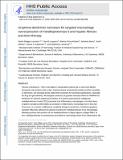| dc.contributor.author | Melgar Lesmes, Pedro | |
| dc.contributor.author | Luquero, Aureli | |
| dc.contributor.author | Parra-Robert, Marina | |
| dc.contributor.author | Mora, Adriana | |
| dc.contributor.author | Ribera, Jordi | |
| dc.contributor.author | Edelman, Elazer R | |
| dc.contributor.author | Jiménez, Wladimiro | |
| dc.date.accessioned | 2020-07-23T19:11:47Z | |
| dc.date.available | 2020-07-23T19:11:47Z | |
| dc.date.issued | 2018-08 | |
| dc.date.submitted | 2018-08 | |
| dc.identifier.issn | 1530-6984 | |
| dc.identifier.issn | 1530-6992 | |
| dc.identifier.uri | https://hdl.handle.net/1721.1/126360 | |
| dc.description.abstract | Fibrosis contributes to ∼45% of all deaths in industrialized nations, but no direct antifibrotic therapeutic interventions exist to date. Graphene-based nanomaterials exhibit excellent versatility in electronics, and emerging trends exploit their properties for biomedical applications, especially for drug and gene delivery. We designed constructs of graphene nanostars linked to PAMAM-G5 dendrimer for the selective targeting and delivery of a plasmid expressing the collagenase metalloproteinase 9 under the CD11b promoter into inflammatory macrophages in cirrhotic livers. Graphene nanostars preferentially accumulated in inflammatory macrophages M1 in less than 3 h in a manner unaffected by covalent linkage to dendrimers. Dendrimer-graphene nanostars efficiently delivered the plasmid encoding for metalloproteinase 9 into macrophages, allowing the synthesis and secretion of the metalloproteinase to digest adjacent collagen fibers. In turn, metalloproteinase 9 overexpression promoted the macrophage switch from inflammatory M1 to pro-regenerative M2 in 3 days. This targeted gene therapy reduced selectively and locally the presence of collagen fibers in fibrotic tracts where inflammatory macrophages accumulated in cirrhotic mice without affecting the activation state of hepatic stellate cells. Overall, this treatment significantly reduced hepatic injury and improved liver restoration in mice with liver cirrhosis treated for 10 days. Graphene-dendrimer nanostars targeted the macrophage overexpression of metalloproteinase 9, selectively reducing hepatic fibrosis, and might be a good treatment for diseases associated with fibrosis and inflammatory macrophage accumulation. | en_US |
| dc.description.sponsorship | National Institutes of Health (Grant R01-GM49039) | en_US |
| dc.language.iso | en | |
| dc.publisher | American Chemical Society (ACS) | en_US |
| dc.relation.isversionof | http://dx.doi.org/10.1021/acs.nanolett.8b02498 | en_US |
| dc.rights | Article is made available in accordance with the publisher's policy and may be subject to US copyright law. Please refer to the publisher's site for terms of use. | en_US |
| dc.source | PMC | en_US |
| dc.title | Graphene–Dendrimer Nanostars for Targeted Macrophage Overexpression of Metalloproteinase 9 and Hepatic Fibrosis Precision Therapy | en_US |
| dc.type | Article | en_US |
| dc.identifier.citation | Melgar-Lesmes, Pedro et al. "Graphene–Dendrimer Nanostars for Targeted Macrophage Overexpression of Metalloproteinase 9 and Hepatic Fibrosis Precision Therapy." Nano Letters 18, 9: 5839–5845 © 2018 American Chemical Society | en_US |
| dc.contributor.department | Massachusetts Institute of Technology. Institute for Medical Engineering & Science | en_US |
| dc.relation.journal | Nano Letters | en_US |
| dc.eprint.version | Author's final manuscript | en_US |
| dc.type.uri | http://purl.org/eprint/type/JournalArticle | en_US |
| eprint.status | http://purl.org/eprint/status/PeerReviewed | en_US |
| dc.date.updated | 2019-10-09T17:55:53Z | |
| dspace.date.submission | 2019-10-09T17:55:57Z | |
| mit.journal.volume | 18 | en_US |
| mit.journal.issue | 9 | en_US |
| mit.metadata.status | Complete | |
